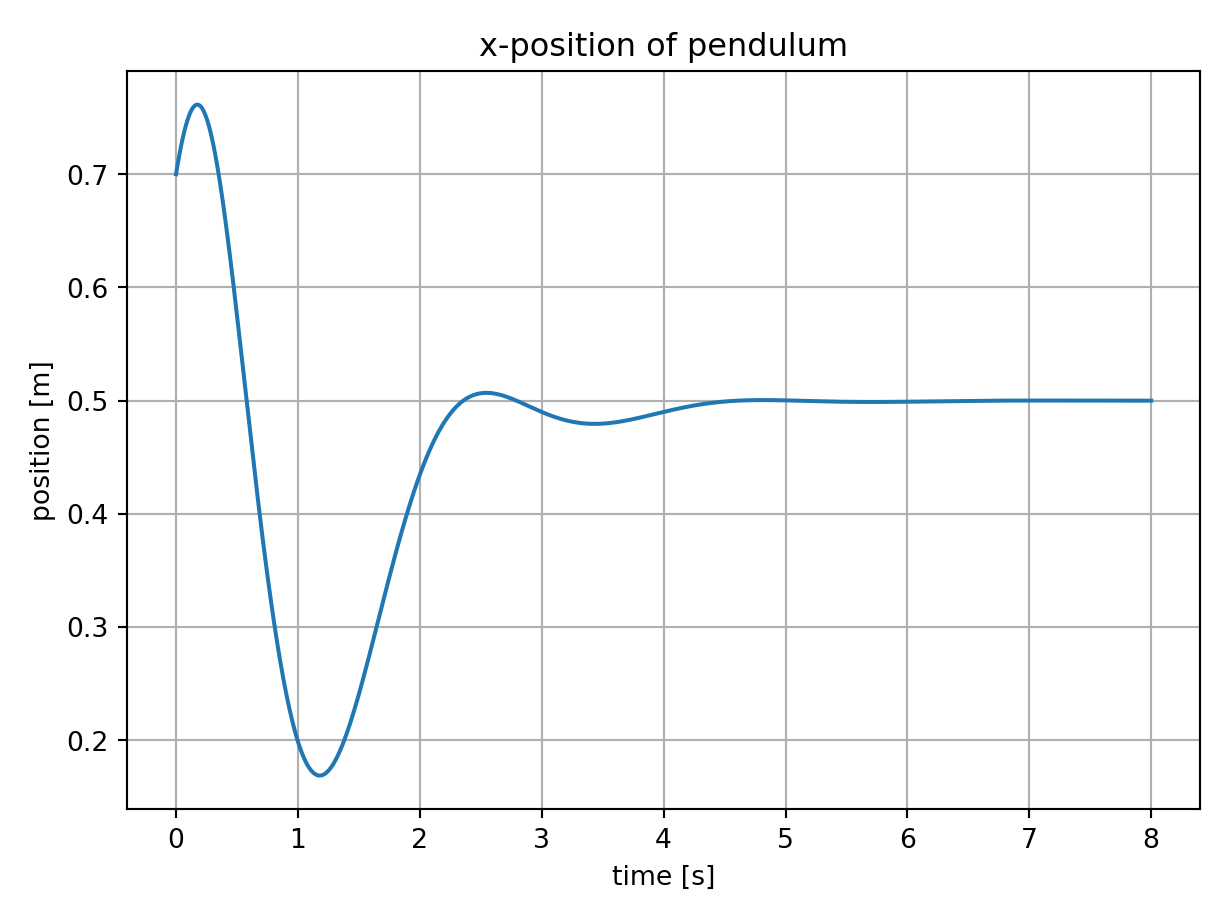Automatic Control Knowledge Repository
You currently have javascript disabled. Some features will be unavailable. Please consider enabling javascript.Details for: "controller design via LQR for cartpole system"
Name: controller design via LQR for cartpole system
(Key: XRV9G)
Path: ackrep_data/problem_solutions/LQR_cartpole_system View on GitHub
Type: problem_solution
Short Description:
Created: 2020-12-30
Compatible Environment: default_conda_environment (Key: CDAMA)
Source Code [ / ] solution.py
Solved Problems: design of the LQR controller to to control and stabilize the x-position of the load |
Used Methods: system proporty full_state_feedback_controller
Result: Success.
Last Build: Checkout CI Build
Runtime: 4.0 (estimated: 10s)
Plot:

The image of the latest CI job is not available. This is a fallback image.
Path: ackrep_data/problem_solutions/LQR_cartpole_system View on GitHub
Type: problem_solution
Short Description:
Created: 2020-12-30
Compatible Environment: default_conda_environment (Key: CDAMA)
Source Code [ / ] solution.py
#!/usr/bin/env python3
# -*- coding: utf-8 -*-
"""
LQR controller design consists of 4 steps:
1. linearize the non-linear system around the equilibrium point.
2. specify weigh matrices
3. calculate state feedback
4. check whether the system have the desired behavior
"""
try:
import method_LQR as mlqr # noqa
import method_system_property as msp # noqa
except ImportError:
from method_packages.method_LQR import method_LQR as mlqr
from method_packages.method_system_property import method_system_property as msp
import matplotlib.pyplot as plt
import symbtools as st
from scipy.integrate import odeint
import sympy as sp
import os
from ackrep_core.system_model_management import save_plot_in_dir
from ipydex import IPS
class SolutionData:
pass
def rhs_for_simulation(f, g, xx, controller_func):
"""
# calculate right hand side equation for simulation of the nonlinear system
:param f: vector field
:param g: input matrix
:param xx: states of the system
:param controller_func: input equation (trajectory)
:return: rhs: equation that is solved
"""
# call the class 'SimulationModel' to build the
# 'right hand side'equation for ode
sim_mod = st.SimulationModel(f, g, xx)
rhs_eq = sim_mod.create_simfunction(controller_function=controller_func)
return rhs_eq
def solve(problem_spec, kwargs=None):
"""the design of a linear full observer is based on a linear system.
therefore the non-linear system should first be linearized at the beginning
:param problem_spec: ProblemSpecification object
:return: solution_data: states and output values of the stabilized system
"""
sys_f_body = msp.System_Property() # instance of the class System_Property
sys_f_body.sys_state = problem_spec.xx # state of the system
sys_f_body.tau = problem_spec.u # inputs of the system
# original nonlinear system functions
sys_f_body.n_state_func = problem_spec.rhs()
# original output functions
sys_f_body.n_out_func = problem_spec.output_func()
sys_f_body.eqlbr = problem_spec.eqrt # equilibrium point
# linearize nonlinear system around the chosen equilibrium point
sys_f_body.sys_linerazition(parameter_values=None)
tuple_system = (sys_f_body.aa, sys_f_body.bb, sys_f_body.cc, sys_f_body.dd) # system tuple
# calculate controller function
LQR_res = mlqr.lqr_method(
tuple_system, problem_spec.q, problem_spec.r, problem_spec.xx, problem_spec.eqrt, problem_spec.yr, debug=False
)
# simulation original nonlinear system with controller
f = sys_f_body.n_state_func.subs(st.zip0(sys_f_body.tau)) # x_dot = f(x) + g(x) * u
g = sys_f_body.n_state_func.jacobian(sys_f_body.tau)
rhs = rhs_for_simulation(f, g, problem_spec.xx, LQR_res.input_func)
res = odeint(rhs, problem_spec.xx0, problem_spec.tt)
output_function = sp.lambdify(problem_spec.xx, sys_f_body.n_out_func, modules="numpy")
yy = output_function(*res.T)
solution_data = SolutionData()
solution_data.res = res # states of system
solution_data.pre_filter = LQR_res.pre_filter # pre-filter
solution_data.state_feedback = LQR_res.state_feedback # controller gain
solution_data.poles = LQR_res.poles_lqr
solution_data.yy = yy[0][0]
save_plot(problem_spec, solution_data)
return solution_data
def save_plot(problem_spec, solution_data):
titles = ["x1", "x2", "x1_dot", "x2_dot"]
# simulation for LQR
plt.figure(1)
for i in range(4):
plt.subplot(2, 2, i + 1)
plt.plot(problem_spec.tt, solution_data.res[:, i], color="k", linewidth=1)
plt.grid(1)
plt.title(titles[i])
plt.xlabel("time t/s")
if i == 0:
plt.ylabel("position [m]")
elif i == 1:
plt.ylabel("angular position [rad]")
elif i == 2:
plt.ylabel("velocity [m/s]")
else:
plt.ylabel("angular velocity [rad/s]")
plt.tight_layout()
save_plot_in_dir("plot1.png")
plt.figure(2)
plt.plot(problem_spec.tt, solution_data.yy)
plt.grid(1)
plt.xlabel("time [s]")
plt.ylabel("position [m]")
plt.title("x-position of pendulum")
plt.tight_layout()
# save image
save_plot_in_dir("plot2.png")
Solved Problems: design of the LQR controller to to control and stabilize the x-position of the load |
Used Methods: system proporty full_state_feedback_controller
Result: Success.
Last Build: Checkout CI Build
Runtime: 4.0 (estimated: 10s)
Plot:

The image of the latest CI job is not available. This is a fallback image.